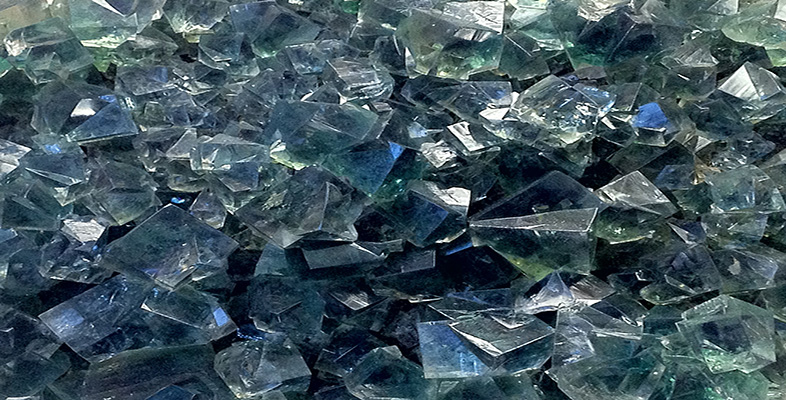3.3.1 Olivine
The name 'olivine' refers to a group of minerals with a continuous spread of chemical compositions between forsterite (Mg2SiO4) and fayalite (Fe2SiO4), and the formula is written as (Mg,Fe)2SiO4, indicating that atoms (in fact, ions) of magnesium and iron can substitute for each other. This kind of chemical mixture is called a solid solution and involves ions having similar sizes and similar charges (e.g. Mg2+ and Fe2+). For a complete solid solution, as developed between forsterite and fayalite, the substituting ions must have similar ionic radii (a measure of their size), so that either ion can fit into the same interstitial site in the crystal structure.
Olivine is an important example of a structure with isolated tetrahedra. Every SiO4 group has a net charge of −4 (Figure 41b), and because the crystal has to be electrically neutral, olivine contains two doubly charged (2+) cations per SiO4 unit. Silicon atoms reside in tetrahedral interstices (i.e. at the centres of SiO4 tetrahedra), whereas octahedral interstices contain the larger magnesium and iron atoms (Section 1.4.2). These are close-packed, largely ionic structures, which explains why, compared with other silicates, olivine has a relatively high density. The structure is also strong in three dimensions, making olivine a hard mineral, without any good cleavage. Olivine has a characteristic olive-green colour (Figure 43a) that becomes darker with increasing iron content.

Olivine is stable at high temperatures and pressures, and forms about 60% of the Earth's upper mantle. It crystallises at high temperatures from magmas rich in iron and magnesium and relatively poor in silica (SiO2). In such rocks, where olivine is one of the first minerals to crystallise as the magma cools, it may develop well-formed crystals, surrounded by later-crystallising minerals (which tend to be smaller, and lack such ideal crystal shapes).
Olivine is prone to alteration at lower temperatures under hydrous conditions, especially during weathering. Under the microscope, evidence of this alteration in olivine crystals takes the form of new minerals, such as greenish or brownish serpentine, and curved, irregular cracks filled with iron oxide (opaque) (Figure 43b and c).
Activity 3.1 Olivine in hand specimen and thin section
Task 1
This activity will help you to recognise olivine in hand specimen and in thin section. For this activity you will require the Digital Kit [Tip: hold Ctrl and click a link to open it in a new tab. (Hide tip)] and the Virtual Microscope.
- Examine the peridotite sample in the Digital Kit. If you could feel it, you'd notice that it feels much denser ('heavier') than other rocks of a similar size. The peridotite sample in the Digital Kit contains olivine that appears brownish-grey and translucent under lights (for photography) and the pyroxene is creamy bronze. The pyroxene can be recognised by its cleavage; but cleavage is lacking in olivine.
- Now use the Digital Kit to examine the gabbro. This rock contains pyroxene and plagioclase as well as olivine.
Question 3.1.1
Describe the textures you see in the gabbro and briefly try to explain the characteristic features that help to identify the minerals.
Answer
The mineral plagioclase is easiest to identify in the gabbro, since it has a white colour and tablular shape. Distinguishing between olivine and pyroxene is much more difficult. You may be able to identify cleavage in the pyroxene and the slightly paler brown colour compared with a more intense green of the olivine, but neither of these colours is entirely diagnostic. This is why geologists use the petrological microscope, where the two minerals have very different appearance to one another and are more easily distinguished.
Task 2
- Examine the gabbro thin section using the Virtual Microscope (under the ‘Igneous rocks’ category). You should become accustomed to using the views in plane-polarised light (PPL), between crossed polars (XP) and the rotations, which are often positioned on good examples of particular minerals. In PPL, the mineral with very high relief, but clear, and criss-crossed by often curved cracks, is olivine (View 2). The cracks here are enlarged and contain alteration products, mainly iron oxides, which exaggerate the appearance of the relief. The olivine is clearly distinguishable from pyroxene, which has more moderate relief and often shows a cleavage (View 1), whereas olivine has no cleavage. There are also green to brown, low-relief areas of alteration at the margins of some olivine crystals that are most probably the mineral serpentine (View 4).
- Now examine the peridotite thin section using the Virtual Microscope. The abundant olivine crystals are more difficult to distinguish from those of pyroxene than they are in the gabbro, because their relief is similar. The olivine can usually be identified by the presence of curved cracks, lack of cleavage and, in XP view, they often have bright interference colours - up to second-order blue (e.g. at coordinates 3200,2230). The pyroxenes have a cleavage and their interference colours are mainly first-order (e.g. at coordinates 3900,2250).
